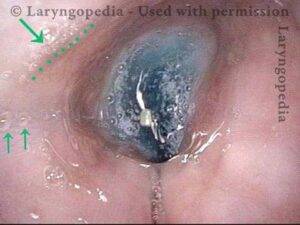Laryngitis & Sore Throats from Acid Reflux
Introduction
 The lower esophageal sphincter (LES) is a muscular “one-way” valve between the stomach and esophagus, whose purpose is to keep stomach contents, especially acid, from refluxing (going backward) up the esophagus towards the mouth.
The lower esophageal sphincter (LES) is a muscular “one-way” valve between the stomach and esophagus, whose purpose is to keep stomach contents, especially acid, from refluxing (going backward) up the esophagus towards the mouth.
Yet, millions of people have a malfunctioning LES. This opens the way to a condition called gastroesophageal reflux disease (GERD), also referred to as “acid reflux.”
Acid Reflux Diagnosis
In a person with GERD, acid may travel upward and burn the lining of the esophagus, causing symptoms and / or esophageal disease (see “Esophageal Symptoms” below). Or, reflux may occur at night while lying down.
In the second instance, acid may reach the level of the throat and come into contact with the larynx (voicebox, vocal colds). To the surprise of some, unless severe, this doesn’t typically waken the person.
An analogy can be made with rain in the night: we may be unaware of gentle rain until the morning comes. This failure to awaken explains why symptoms can be more elusive (see “Laryngopharynx Symptoms” below)—and why we sometimes do a trial of treatment in persons who don’t think they have acid reflux or GERD.
Esophageal Symptoms
- Heartburn
- Acid Belching
Laryngopharynx (voicebox and throat) Symptoms
- Dry, scratchy, or irritated throat, often worse in the morning and improving throughout the day.
- Noticeable morning throat mucus
- Throat clearing
- Chronic irritative cough
- Noted especially in singers: husky, “heavy,” or low-pitched morning voice, often requiring prolonged singing voice warm-up (“I’m not a morning singer.”)
Treatment Measures
(Do all of these, particularly during the initial treatment trial)
- Avoid caffeine, alcohol, spicy foods, mint, citrus, carbonated beverages, vinegar-based salad dressings, garlic, and chocolate, particularly after 2:00 p.m. These substances may increase stomach acidity and/or make the LES function poorly, thereby worsening GERD.
- Drugs to avoid: anticholinergics, theophylline, diazepam, narcotics, calcium channel blockers, beta-agonists, progesterone, and alpha-antagonists.
- Eat the last meal/snack of the day no fewer than three hours before going to sleep. In addition, try to eat the heavier meal of the day at noon and a lighter one in the evening.
- Ideally, the stomach will be relatively empty when lying down so there is not a lot of “back pressure” to push stomach contents up the esophagus and into the throat.
- Use four- to six-inch bed blocks under the head posts of the bed. Old books or wooden blocks work well for this purpose. This procedure puts the entire bed on a slight downward slant from head to foot. During sleep, gravity now assists in keeping stomach acid where it belongs. Some persons prefer instead to sleep with a large foam wedge under the entire upper body. These wedges are available from “bed and bath” or medical equipment supply stores.
- Watch your weight! Extra pounds increase pressure on the abdomen and can aggravate acid reflux.
- Use one of the following MEDICAL REGIMENS to either prevent the stomach from making acid (1 and 2 below), or to neutralize existing acid (3 below). They are, listed by class from strongest to weakest:
- Prilosec, Prevacid, Protonix, Aciphex, or Nexium (the class of medications called proton pump inhibitors or PPI’s which prevent acid production). Take one of these 30-60 minutes before breakfast for primarily daytime esophageal symptoms and / or one hour before dinner to decrease acidity of nocturnal reflux coming up to the level of the throat and voicebox.
- Zantac, Pepcid, Axid, or Tagamet (the class of medications called H2 Blockers). You may double the dose if the over the counter preparation is used. Take in the morning, or when the laryngopharynx is the focus, a couple of hours before bed, to control nighttime acidity.
- Antacids such as Gaviscon, Mylanta, Maalox, Tums. These can be taken whenever symptoms occur. To prevent nighttime acid burns to the throat, take an antacid just before bed.
Occasionally, various combinations of the medications above are also utilized.
Conclusion
It is recommended that a trial of the above measures be continued for a minimum of two weeks and that none of the treatments 1-5 outlined above are omitted. Again, the best initial strategy is to do all of the above treatments, including using one of the PPI’s, and sometimes all three classes of medication, in order to get an answer quickly concerning the effect acid reflux is having on you.
Thereafter, it can be appropriate for you to experiment by dropping one or more of the medications / restrictions, in order to find the simplest regimen that suffices for you. Be aware, however, that some individuals will need to follow all measures on a long-term, indefinite basis. If you have further questions, do not hesitate to call your physician/nurse.
Share this article
Teleconversation with Dr Bastian
Still have questions? Schedule a call with Dr. Bastian via Zoom.
See Acid Reflux in action!
Take a look at what heartburn (acid reflux) looks like from inside your esophagus.